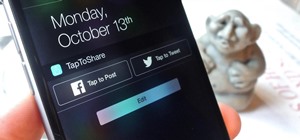

If you click on Click to Post, you can choose who can view your post on Facebook-everyone, friends, only me, family, close friends, or acquaintances. To use these buttons, just click on one and a small text window will drop down where you can enter your tweet or Facebook post. If you’ve set up Twitter and/or Facebook accounts within the Mail, Contacts & Calendars system preference (something we’ll discuss in the future), you’ll also find ‘Click to Tweet’ and/or ‘Click to Post’ buttons in this area. It will turn gray, indicating that notifications have been switched off. If you find it too much trouble to use the switch, you can simply hold down the Option key and click on the Notification Center icon in the menu bar.

You might use this feature if your Mac sits nearby your sleeping form and you’d rather not have late-night audio alerts wake you. You use this switch to disable notifications until the next day (at which point the switch automatically toggles back on) or until you manually switch them back on, whichever occurs first. This is akin to iOS’s Do Not Disturb feature (though the OS X implementation doesn’t allow you to schedule when notifications are blocked). Here you’ll find a ‘Show Alerts and Banners’ entry with an On/Off toggle switch next to it. You can view it by swiping up or down on a trackpad (depending on how you’ve configured the trackpad’s scroll direction) or use the scrollwheel/ball on a mouse for this same purpose. Instead, Calendar notifications automatically disappear after events have taken place.Ībove these notifications is a hidden area. The exception to this behavior is Calendar.

The heading will reappear when that application next generates a notification. The heading and its notifications will disappear. To remove notifications from beneath most headings, just click the small X that appears next to the heading’s name.


 0 kommentar(er)
0 kommentar(er)
